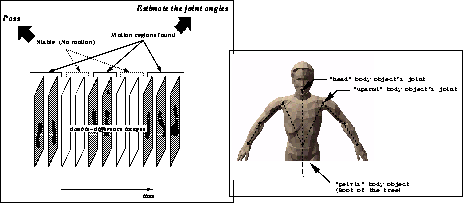Contents of this page are obsolete.
This page is preserved and stored at this URL just from historical viewpoint.
Original URL was http://www.mm.media.kyoto-u.ac.jp/members/kameda/...
Please visit
www.kameda-lab.org
for recent information. (2002/12/06, [email protected])
Publication,
Research,
Docs and Info,
KAMEDA



Next: Motion Estimation Algorithm
Up: No Title
Previous: Double-difference image
A human body is represented by an articulated object model which
consists of several solid body objects. A solid object corresponds to
a part of the human body and has a joint to the adjacent body object.
The body objects are connected to each other in a tree structure.
According to the tree graph structure, pose of one body object is
defined directly by the joint angles that is a attribute of the joint
connecting it to a parent body object in the tree. A joint has at most
3 axes to rotate. Joint angles of the body object i at time t are
expressed by a vector  . The
subscript k means the axis of the joint rotation. The minimum and
maximum joint angle are defined so that a human model does not come to
an unrealistic pose. Figure 4 shows a human body model
consisting of nine parts. The pelvis corresponds to the root body
object. Black dots on the model represents the joints. For example, a joint
of the head body part locates near the mouth in the figure. Dotted
lines denotes the tree structure of this model.
. The
subscript k means the axis of the joint rotation. The minimum and
maximum joint angle are defined so that a human model does not come to
an unrealistic pose. Figure 4 shows a human body model
consisting of nine parts. The pelvis corresponds to the root body
object. Black dots on the model represents the joints. For example, a joint
of the head body part locates near the mouth in the figure. Dotted
lines denotes the tree structure of this model.
In this way, the motion is defined by the time varied angles of all
the joints for a certain period.

Figure 3: Frame Skip ,Figure 4: Human Body Model
Yoshinari Kameda
Mon Apr 7 22:34:43 JST 1997
 . The
subscript k means the axis of the joint rotation. The minimum and
maximum joint angle are defined so that a human model does not come to
an unrealistic pose. Figure 4 shows a human body model
consisting of nine parts. The pelvis corresponds to the root body
object. Black dots on the model represents the joints. For example, a joint
of the head body part locates near the mouth in the figure. Dotted
lines denotes the tree structure of this model.
. The
subscript k means the axis of the joint rotation. The minimum and
maximum joint angle are defined so that a human model does not come to
an unrealistic pose. Figure 4 shows a human body model
consisting of nine parts. The pelvis corresponds to the root body
object. Black dots on the model represents the joints. For example, a joint
of the head body part locates near the mouth in the figure. Dotted
lines denotes the tree structure of this model.



